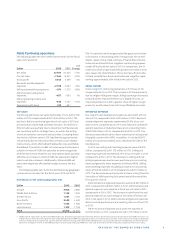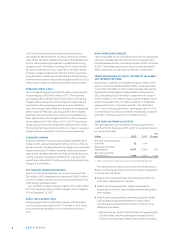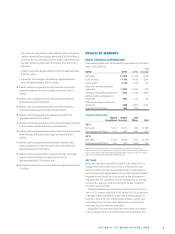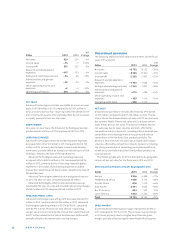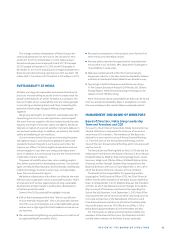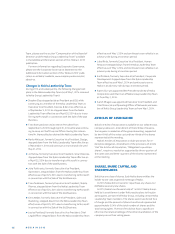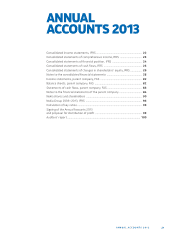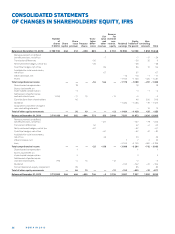Nokia 2013 Annual Report Download - page 19
Download and view the complete annual report
Please find page 19 of the 2013 Nokia annual report below. You can navigate through the pages in the report by either clicking on the pages listed below, or by using the keyword search tool below to find specific information within the annual report.REVIEW BY THE BOARD OF DIRECTORS 17
On December , , Nokia and its subsidiary compa-
nies owned Nokia shares. The shares represented
approximately .% of the total number of the shares of the
company and the total voting rights. The total number of
shares at December , , was . On December
, , Nokia’s share capital was EUR ..
Information on the authorizations held by the Board in
to issue shares and special rights entitling to shares, transfer
shares and repurchase own shares, as well as information on
related party transactions, the shareholders, stock options,
shareholders’ equity per share, dividend yield, price per earn-
ings ratio, share prices, market capitalization, share turnover
and average number of shares are available in the Annual
Accounts and Additional Information sections.
NOKIA OUTLOOK
Continuing Operations
■ Nokia expects Networks operating margin for the full year
to be towards the higher end of Networks’ targeted
long term operating margin range of % to %. In addi-
tion, Nokia now expects Networks’ net sales to grow on a
year-on-year basis in the second half of . This outlook
is based on Nokia’s expectations regarding a number of fac-
tors, including:
• competitive industry dynamics;
• product and regional mix;
• the timing of major new network deployments; and
• expected continued improvement under Networks’
transformation programs.
■ In , Nokia expects HERE to invest to capture longer term
transformational growth opportunities. This is expected to
negatively aff ect HERE’s operating margin, excluding
special items and purchase price accounting related items.
■ Nokia expects Technologies annualized net sales run rate to
expand to approximately EUR million during , now
that Microsoft has become a more signifi cant intellectual
property licensee in conjunction with the Sale of the D&S
Business.
■ Until a pattern of tax profi tability is re-established in
Finland, Nokia continues to expect to record approximately
EUR million of annualized tax expense for the continuing
operations. This corresponds to the anticipated cash tax
obligations for Networks, HERE and Technologies. After a
pattern of tax profi tability is re-established in Finland, Nokia
expects to record tax expenses at a long term eff ective tax
rate of approximately %, however Nokia’s cash tax obliga-
tions are expected to remain at approximately EUR
million annually until Nokia’s currently unrecognized Finnish
deferred tax assets have been fully utilized.
■ Nokia expects full year capital expenditures for con-
tinuing operations to be approximately EUR million,
primarily attributable to Networks.
RISK FACTORS
Set forth below is a description of risk factors that could aff ect
Nokia. There may be, however, additional risks unknown to
Nokia and other risks currently believed to be immaterial that
could turn out to be material. These risks, either individually or
together, could adversely aff ect our business, sales, profi tabil-
ity, results of operations, fi nancial condition, liquidity, market
share, brand, reputation and share price from time to time.
Unless otherwise indicated or the context otherwise provides,
references in these risk factors to “Nokia”, “we”, “us” and “our”
mean Nokia’s consolidated operating segments.
■ Nokia has announced a new strategy which is subject to
various risks and uncertainties, including that Nokia may not
be able to sustain or improve the operational and fi nancial
performance of its continuing businesses or that Nokia may
not be able to correctly identify business opportunities or
successfully pursue new business opportunities.
■ Networks’ strategy focuses on mobile broadband and ac-
cordingly its sales and profi tability depend on its success in
the mobile broadband infrastructure and related services
market. Networks may fail to execute its strategy or to ef-
fectively and profi tably adapt its business and operations in
a timely manner to the increasingly diverse solution needs
of its customers in that market or technological develop-
ments.
■ Networks faces intense competition and may fail to eff ec-
tively and profi tably invest in new competitive high-quality
products, services, upgrades and technologies and to bring
them to market in a timely manner.
■ Our intellectual property (IP) portfolio includes various
patented standardized or proprietary technologies on
which our products and services depend and we also use our
IP portfolio for revenue generation. Third parties may use
without a license and unlawfully infringe our IP or commence
actions seeking to establish the invalidity of the intellectual
property rights of these technologies, or we may not be able
to suffi ciently invent new relevant technologies, products
and services to develop and maintain our IP portfolio, main-
tain the existing sources of intellectual property related
revenue or establish new sources.


